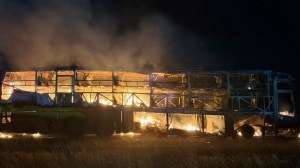On the road to Mandalay
After a smooth ride on a superhighway that appeared to have been transplanted from Europe, we finally hit the Old Burma Road, which incor...

After a smooth ride on a superhighway that appeared to have been transplanted from Europe, we finally hit the Old Burma Road, which incorporates parts of the legendary Stillwell Road that was built during the Second World War to outflank advancing Japanese imperial forces that had established a stranglehold on Southeast Asia, including Burma.
When I say hit, I mean that literally. The transition from smooth tarmac to a very uneven, two-lane road with potholes and a goodly amount of traffic was striking. It also gave one a comfortable feeling of being at home: the roads in the Northeast of India or any other part of the country are not very different to these, after all. The broad streets of Kunming and the giant highways were not the only significant faces of China — it had other aspects, different, open, if not inscrutable.
During the nearly 1,000 km journey, spread over two days, we were hosted warmly and extensively by members of local districts or prefectures of Yunnan Province, in China’ssouth-west. These included leaders of ethnic communities which are also to be found in our Northeast — Lisus and Singphos as well as Tais (they are called Dais in Yunnan).
By `we’, I am referring to members of the Indian delegation led by B.G. Verghese, author and visionary, and C.V. Ranganathan, former Indian Ambassador to China and France.
Our group comprised largely of members of the Centre for Policy Research and a few others, including Dr Jayanta Madhab, former Director of the Asian Development Bank and Chairman of the Northeast Development Finance Corporation, as well as T.N. Ninan, Executive Editor of The Business Standard. We had gone to attend a conference on Regional Cooperation between India, China, Myanmar and Bangladesh at Kunming, capital of Yunnan Province, which was hosted by the Yunnan Academy of Social Sciences.
Last-minute additions included Arun Sarma, the Rajya Sabha MP from Assam and Prodip Hazarika, the state’s Minister for Transport. Verghese and Ranganathan did not travel tothe border, leaving me as the sole CPR representative in the presence of the other Indians as well as about 11 Chinese participants from the conference, including two interpreters from the Foreign Office in Yunnan. Indeed, each province in China has a Foreign Office, whose job it is to coordinate with the Central Foreign Ministry and visiting foreign delegates, businessmen and others and also function as a public relations office.
On the road to the Myanmar border, we passed remarkable scenery, transiting from pine forests and conifers in the hills to banyan and banana trees in the plains as well as arecanut and paan trees. The hills and valleys reminded one of the Northeastern countryside while the small clusters of houses, each with its boat-styled, brown-tiled roof, were similar to those in the landscapes of Southeast Asia. From one or two roofs, proclaiming their prosperity, a few householders had raised white satellite dishes.
But here, as at Kunming, we were struck by the cleanliness of the placeswe visited — and these included areas that were not on the official itinerary, including tea-stalls and small roadside markets. I am sure that all of Yunnan is not flawless, but the little we saw of it was all the more impressive because of the high levels of cleanliness and because this was one of Beijing’s poorer cousins. However, the public toilets leave a great deal to be desired in terms of sanitation and smells — as do ours!
We passed Dali, Baoshan, Menghsu and Wangding before reaching Ruli on the China-Myanmar border. We crossed over after paying a $10 fee (all Indians paid but the Chinese did not, since they were covered by a bilateral arrangement). The region looked even more Southeast Asian and less developed. The road became narrower, there were fewer new-looking cars, the markets looked like those of Imphal and Moreh in Manipur.
Indeed, China has built a large border trading and manufacturing zone on the Myanmar side of Ruli (called Jekhow in Myanmar). this is intended to be a magnet forborder trade as well as to draw people away from the attractive commercial centres of China and Myanmar, to the benefit of the underdeveloped areas.
Driving further into Myanmar, we stopped at the trade post of Museh, where the local commander told us that it was the "biggest border trade point" for his country and that nearly 80 per cent of all trade came through this place. Most of the goods imported were "essential commodities" in Myanmar, a country that has been targeted for sanctions by the international community for its crackdown on its pro-democracy movement. These sanctions are clearly beginning to ease and Yangon has found greater acceptability in South and Southeast Asia, for a start.
There are extensive opportunities for trade and mutual development among the frontier states of the three major countries that have long boundaries with each other — China, Myanmar and India. Bangladesh can be a factor too. This region, so long neglected and impoverished, can turn to its inner resources and thenations and the communities that comprise it to generate change and progress. A powerful beginning has been made in Yunnan — and that highway from Kunming will not be complete until it links up with Myanmar and India, through Mizoram and Assam, to connect the hundreds of millions of people at either end who comprise both markets and opportunities.



- 01
- 02
- 03
- 04
- 05




























